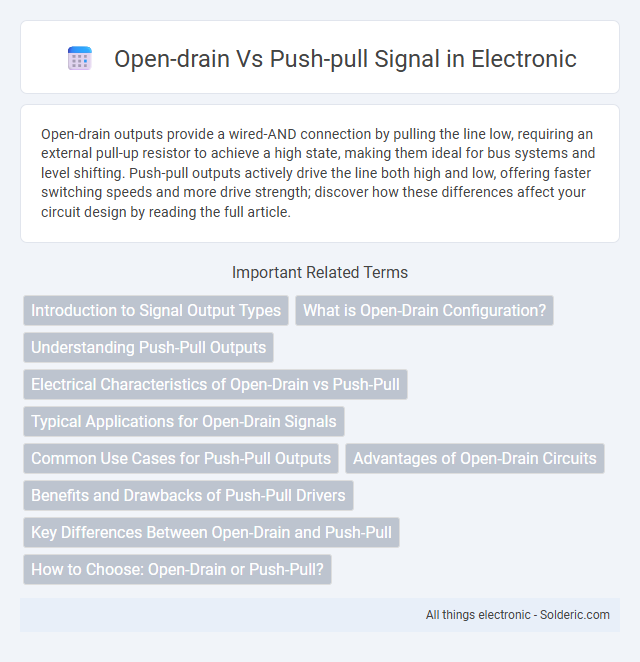Open-drain outputs provide a wired-AND connection by pulling the line low, requiring an external pull-up resistor to achieve a high state, making them ideal for bus systems and level shifting. Push-pull outputs actively drive the line both high and low, offering faster switching speeds and more drive strength; discover how these differences affect your circuit design by reading the full article.
Comparison Table
| Feature | Open-Drain | Push-Pull |
|---|---|---|
| Definition | Transistor output that sinks current; requires external pull-up resistor | Transistor output actively drives both high and low levels |
| Output Levels | Can only pull low; high level via pull-up resistor | Can actively drive both high and low voltage levels |
| Power Consumption | Lower when output is high (no current through transistor) | Higher due to active driving of both states |
| Signal Speed | Slower rise time due to resistor and capacitive effects | Faster switching times due to active drive |
| Wiring | Allows wired-AND connection of multiple outputs | Outputs cannot be connected together safely |
| Applications | Used in I2C bus, open-collector communication | Used for general-purpose digital outputs requiring fast switching |
| Protection | Less risk of short circuits when outputs conflict | Risk of damage if outputs are shorted together |
Introduction to Signal Output Types
Open-drain and push-pull are common output signal types used in digital electronics to interface with various components. Open-drain outputs can only sink current, requiring an external pull-up resistor to drive the line high, making them ideal for wired-AND configurations and multiple device communication. Push-pull outputs actively drive the line both high and low, providing faster transitions and stronger signal integrity for single device control.
What is Open-Drain Configuration?
Open-drain configuration refers to a transistor output stage where the transistor can only pull the line to ground, requiring an external pull-up resistor to achieve a high logic level. This setup allows multiple devices to share the same wire for communication, facilitating wired-AND logic and reducing bus contention in protocols like I2C. Open-drain outputs are essential in applications demanding multiple nodes to drive a common signal line without damaging each other.
Understanding Push-Pull Outputs
Push-pull outputs actively drive a signal both high and low, providing fast switching speeds and strong voltage levels for improved noise immunity in digital circuits. This configuration uses two transistors that alternately connect the output to voltage supply or ground, enabling precise control over the output state. Understanding push-pull outputs helps you design efficient interfaces that ensure clear, reliable signal transmission with minimal power loss.
Electrical Characteristics of Open-Drain vs Push-Pull
Open-drain outputs typically operate by pulling the line low and relying on an external pull-up resistor to achieve a high state, resulting in slower rise times and higher power consumption during switching due to resistor-induced current flow. Push-pull outputs actively drive the line both high and low, providing faster transitions, lower output impedance, and improved signal integrity with reduced noise susceptibility. The open-drain configuration excels in wired-AND or multi-device bus scenarios, while push-pull is preferred for higher-speed digital signals requiring stronger drive capability and minimal voltage drop.
Typical Applications for Open-Drain Signals
Open-drain signals are commonly used in I2C communication buses, allowing multiple devices to share a single data line without contention by using wired-AND logic. They are ideal for interrupt signaling in microcontroller systems where multiple sources need to trigger a shared interrupt line safely. Open-drain outputs are also favored in level shifting applications, providing compatibility between different voltage domains by enabling safe voltage translation.
Common Use Cases for Push-Pull Outputs
Push-pull outputs are commonly used in digital circuits requiring fast switching and strong drive capability, such as microcontroller GPIO pins controlling LEDs, motors, or other digital devices. Their ability to actively drive the output high or low reduces signal distortion and noise, making them ideal for high-speed communication interfaces like SPI and UART. You benefit from more precise voltage control and faster transitions, ensuring reliable performance in systems demanding quick and consistent output signals.
Advantages of Open-Drain Circuits
Open-drain circuits offer significant advantages such as simplicity in wired-AND configurations and the ability to interface with different voltage levels through pull-up resistors, enhancing compatibility across mixed-voltage systems. These circuits provide fault tolerance by allowing multiple devices to share a single communication line without contention, improving system reliability. Their low power consumption and noise immunity make open-drain outputs ideal for I2C bus communication and other multi-device signaling applications.
Benefits and Drawbacks of Push-Pull Drivers
Push-pull drivers provide fast switching speeds and strong drive capability, enabling efficient signal transmission with minimal distortion. They deliver both high and low logic levels actively, reducing susceptibility to noise and improving signal integrity in digital circuits. However, push-pull drivers can cause increased power consumption and potential damage from contention if both drivers attempt to drive opposing logic levels simultaneously.
Key Differences Between Open-Drain and Push-Pull
Open-drain outputs pull the line low or leave it floating, requiring an external pull-up resistor to achieve a high level, while push-pull outputs actively drive the line both high and low using internal transistors. You should choose open-drain for wired-AND logic or when multiple devices share a signal line, ensuring safe bus arbitration and preventing contention. Push-pull configurations offer faster switching speeds and stronger drive capability, making them ideal for full rail-to-rail digital signals in single-device control scenarios.
How to Choose: Open-Drain or Push-Pull?
Choosing between open-drain and push-pull signals depends on your circuit requirements for voltage levels and bus configurations. Open-drain outputs are ideal for wired-AND logic, allowing multiple devices to share a line without damaging each other, commonly used in I2C communication. Push-pull outputs provide faster switching and stronger drive capability for single-device lines, offering better noise immunity and higher speed for your digital signals.
Open-drain vs push-pull signal Infographic

 solderic.com
solderic.com